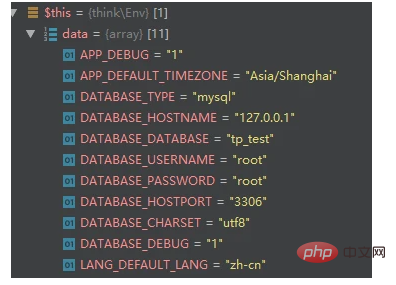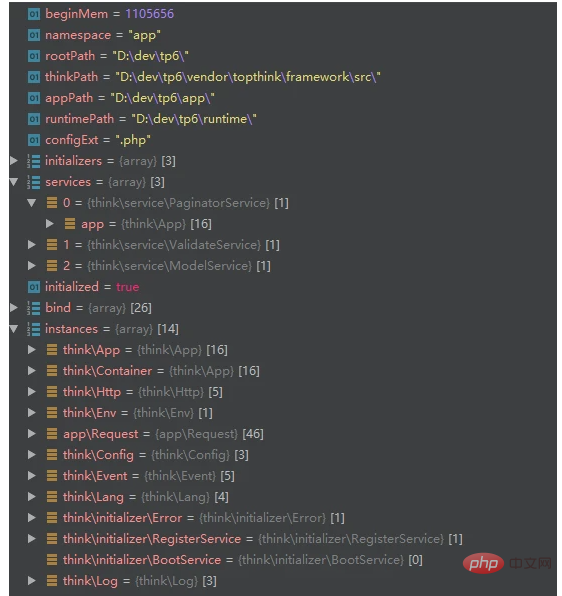runWithRequest () 方法
在 http 类的 run() 方法中,得到 think\\request 类的实例后,程序接着执行 $response = $this->runwithrequest(request); 。其中,runwithrequest() 方法前面几行如下:
protected function runWithRequest(Request $request)
{
$this->initialize();
// 加载全局中间件
$this->loadMiddleware();
.
.
.该方法第一行执行 $this->initialize();,对应用进行初始化,接下来详细分析这一初始化操作。 Http 类的 initialize() 方法:
protected function initialize()
{
//如果还未初始化,则初始化之
if (!$this->app->initialized()) {
$this->app->initialize();
}
}实际上是调用 App 类的 initialize() 方法。该方法代码:
public function initialize()
{
// 设置应用状态为已经初始化
$this->initialized = true;
//记录开始时间
$this->beginTime = microtime(true);
//记录起始内存使用量
$this->beginMem = memory_get_usage();
// ==( A )== 加载环境变量
// $this->env跟前面的(new App())->http和$this->config都是同样的套路
if (is_file($this->rootPath . '.env')) {
$this->env->load($this->rootPath . '.env');
}
//设置配置文件后缀
$this->configExt = $this->env->get('config_ext', '.php');
// ==( B )== 设置调试模式
$this->debugModeInit();
// ==( C )== 加载应用文件和配置等操作
$this->load();
// 加载框架默认语言包
$langSet = $this->lang->defaultLangSet();
// 框架目录下对应的语言包
// 比如:D:\dev\tp6\vendor\topthink\framework\src\lang\zh-cn.php
$this->lang->load($this->thinkPath . 'lang' . DIRECTORY_SEPARATOR . $langSet . '.php');
// 加载应用默认语言包
// 这个会扫描「app/lang」里面,对应语言包文件夹的所有「.php」文件
// 比如,app/lang/zh-cn/* 下的所有文件
// 然后加载解析
$this->loadLangPack($langSet);
// 监听AppInit
$this->event->trigger('AppInit');
// 设置时区
date_default_timezone_set($this->config->get('app.default_timezone', 'Asia/Shanghai'));
// ==( D )== 初始化
// 初始化错误和异常处理、注册系统服务和初始化系统服务
foreach ($this->initializers as $initializer) {
$this->make($initializer)->init($this);
}
return $this;
}应用的初始化做了大量的操作,其主要的操作有:加载环境变量、加载配置文件,加载语言包、监听 AppInit、initializers 数组包含的类的初始化。
(A) 加载环境变量
对应语句:$this->env->load($this->rootPath . ‘.env’);,其中,$this->env,与前面的 (new App())->http 原理是一样的(参见第一篇),它可以取得 \think\Env 类的实例。取得 Env 类实例后,调用 load() 方法,传入的参数是.env 文件所在地址。load() 方法实现如下:
public function load(string $file): void
{
$env = parse_ini_file($file, true) ?: [];
$this->set($env);
}该方法读取.env 文件的值后,调用 set() 方法,将配置保存在 Env 类的 $data 成员变量。set() 方法代码:
public function set($env, $value = null): void
{
if (is_array($env)) {
//全部KEY转为大写字母
$env = array_change_key_case($env, CASE_UPPER);
foreach ($env as $key => $val) {
//有二级配置的,转为KEY1_KEY2 => $v 的形式
if (is_array($val)) {
foreach ($val as $k => $v) {
$this->data[$key . '_' . strtoupper($k)] = $v;
}
} else {
$this->data[$key] = $val;
}
}
//ENV的值不是数组的情况
} else {
$name = strtoupper(str_replace('.', '_', $env));
$this->data[$name] = $value;
}
}从.env 读取到的值大概是这样的: 
$this->set($env) 之后得到的大概是这样的:

(B) 调试模式设置
$this->debugModeInit() 运行原理详见注释。
protected function debugModeInit(): void
{
// 应用调试模式
if (!$this->appDebug) {
$this->appDebug = $this->env->get('app_debug') ? true : false;
// 关闭错误显示
ini_set('display_errors', 'Off');
}
// 如果不是命令行模式
if (!$this->runningInConsole()) {
// 重新申请一块比较大的buffer
// php缓冲控制
// 参考:https://www.php.net/manual/en/ref.outcontrol.php
// https://www.cnblogs.com/saw2012/archive/2013/01/30/2882451.html
// 新版PHP默认开启缓冲区ob_start(),ob_get_level() == 1
if (ob_get_level() > 0) {
// 相当于ob_get_contents() 和 ob_clean()
// 获取缓冲区内容并删除缓冲区内容
$output = ob_get_clean();
}
// 开启新的缓冲区控制
ob_start();
if (!empty($output)) {
// 由于开启了新的缓冲区控制,
// 这里不会直接输出$output
// 而是等到依次执行了ob_flush()和flash()之后才将内容输出到浏览器
echo $output;
}
}
}需要注意的是,这里貌似有个 Bug,应该先执行 $this->appDebug = $this->env->get('app\_debug') ? true : false; 获取是否是调试模式的配置,然后再判断:if(!$this->appDebug)。
(C)加载应用文件和配置等操作
接下来执行 $this->load();,「load」方法具体实现如下:
protected function load(): void
{
$appPath = $this->getAppPath();
// 加载「app」目录下的「common.php」文件
if (is_file($appPath . 'common.php')) {
include_once $appPath . 'common.php';
}
// 加载核心目录下的「helper.php」文件
// 可以看到,这里的加载顺序:先「common.php」,后「helper.php」
// 且「helper.php」中的函数包裹在「if (!function_exists('xxx'))」下
// 所以可以在「common.php」文件中覆盖系统定义的助手函数
include_once $this->thinkPath . 'helper.php';
$configPath = $this->getConfigPath();
$files = [];
// glob的作用是扫描给定路径模式下的文件,非常好用
// 这里扫描「config」目录下的所有「.php」文件
if (is_dir($configPath)) {
$files = glob($configPath . '*' . $this->configExt);
}
foreach ($files as $file) {
// $this->config 还是同样的套路获得了「Config」类的实例
// 「load」的第二个参数为一级配置名,这里传入一个文件名,所有文件名作为一级配置
// 比如「app.php」配置文件,一级配置为「app」
// 在 「Config」类作用域下的操作:
// 「load」加载文件后,通过「parse」方法解析文件内容
// 最后,通过「set」方法将所有配置合并了「config」成员变量
$this->config->load($file, pathinfo($file, PATHINFO_FILENAME));
}
// 加载「app」目录下的「event.php」文件
if (is_file($appPath . 'event.php')) {
$this->loadEvent(include $appPath . 'event.php');
}
// 注册自定义的服务
if (is_file($appPath . 'service.php')) {
$services = include $appPath . 'service.php';
foreach ($services as $service) {
$this->register($service);
}
}
}值得一提的是,程序先加载「common.php」,后加载「helper.php」,而「helper.php」中的函数包裹在「if (!function_exists (‘xxx’))」下,所以我们如果有需要,可以在「common.php」文件中覆盖系统定义的助手函数。
除了加载这两个文件,该方法还扫描了「config」目录下的所有配置文件,并将其加载到 Config 类的 $config 成员变量,加载了「app」目录下的「event.php」文件,以及加载并注册自定义的服务。
(D) 初始化错误和异常处理、注册系统服务和初始化系统服务
接着,看初始化函数的最后一段:
foreach ($this->initializers as $initializer) {
$this->make($initializer)->init($this);
}这几行代码做了比较多的操作:分别实例化包含在里面的类,然后调用其「init」方法。initializers 数组的值如下:
protected $initializers = [ Error::class, //错误处理类 RegisterService::class, //注册系统服务类 BootService::class, //启动系统服务 ];
略过系统错误处理类,先看注册系统服务类。值得注意的是,这个类有一个成员变量:
protected $services = [ PaginatorService::class, ValidateService::class, ModelService::class, ];
包含了三个系统核心服务。在其 init 方法中,这些服务被注册到系统服务,与前面的自定义服务合并起来,其主要实现代码:
foreach ($services as $service) {
if (class_exists($service)) {
// 注册到系统服务
$app->register($service);
}
}最后实例化的是启动系统服务类,该类的 init 方法仅调用了 App 类的 boot 方法,该方法的作用是初始化每个系统服务,也就是调用每个服务的 boot 方法。
启动系统服务类实现如下:
class BootService
{
public function init(App $app)
{
$app->boot();
}
}App 类的 boot 方法:
public function boot(): void
{
array_walk($this->services, function ($service) {
$this->bootService($service);
});
}其中关键是 bootService 方法:
public function bootService($service)
{
if (method_exists($service, 'boot')) {
return $this->invoke([$service, 'boot']);
}
}该方法分别调用了每个服务的 boot 方法,从而初始化已注册的服务。
从以上代码可以看到,系统注册的服务的来源有三个地方:
- 系统自带的,如
PaginatorService,ValidateService,ModelService; - app 目录下,在「service.php」文件中自定义的;
- vendor 目录下的「service.php」文件定义的。
初始化之后,「App」类的实例大概是这样子的:

